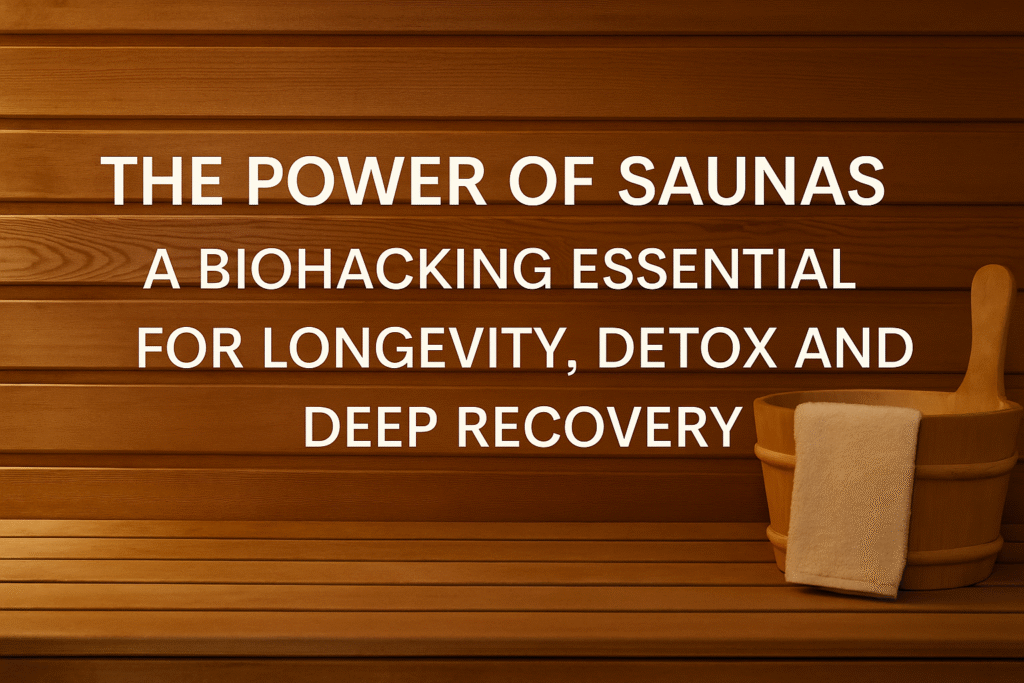
There’s something ancient and deeply healing about stepping into a hot, steamy space and simply letting go. Saunas aren’t just a luxury. They are one of the most underrated wellness tools for deep recovery, cellular rejuvenation and graceful ageing.
Across cultures, from the Finnish forests to Ayurvedic sweat therapies in India, heat has been used for centuries to cleanse, restore and reset the body. Today, modern science is finally catching up with what our ancestors intuitively knew—saunas are powerful medicine.
And when used with intention, they become a smart, science-backed biohack for boosting longevity, immunity, mental clarity and more.
Why Sauna Therapy Matters for Cellular Health and Longevity
When you expose your body to controlled heat stress, you activate a number of beneficial responses. Your heart rate increases, circulation improves, blood vessels expand, and your body begins to mimic the effects of moderate exercise. This process is known as hormesis, a mild stressor that strengthens the body over time.
Regular sauna use has been linked to improved cardiovascular health, reduced inflammation, enhanced detoxification, better muscle recovery, boosted growth hormone levels, and healthier skin. It also promotes restful sleep and helps calm the nervous system.
In fact, a large-scale Finnish study published in JAMA Internal Medicine found that men who used saunas four to seven times a week had a significantly lower risk of cardiovascular disease and all-cause mortality.
Now let’s explore the different types of saunas and how they can support your long-term wellbeing.
Traditional Finnish Sauna (Dry Heat)
Temperature: 70–100°C
Humidity: Low (approximately 10 to 20 percent)
This is the classic sauna experience—wood-panelled rooms heated with stones placed over a stove. Water can be splashed on the stones to create a brief burst of steam, though the environment remains dry overall.
Key benefits:
Improves circulation, promotes deep sweating, supports cardiovascular health, and stimulates the production of heat shock proteins that aid cellular repair. Many people also report improved mood and mental clarity post-session.
Best for: Those who enjoy a more intense heat experience and traditional wellness rituals.
Infrared Sauna (Light-Based Heat)
Temperature: 45–65°C
Humidity: None
Unlike traditional saunas that heat the air, infrared saunas use light waves to warm the body directly from within. The result is a gentler, more tolerable heat that still triggers deep sweating and detoxification.
Key benefits:
Supports detox through lymphatic drainage, reduces inflammation and muscle soreness, stimulates collagen production for healthier skin, and promotes a calming parasympathetic response.
Best for: Beginners, those with inflammatory conditions, or anyone seeking a relaxing yet effective detox.
Steam Room (Wet Heat)
Temperature: 40–50°C
Humidity: 100 percent
Often confused with saunas, steam rooms provide moist heat rather than dry heat. They are excellent for respiratory health and skin hydration.
Key benefits:
Opens up airways and clears sinuses, supports lung health, hydrates the skin, soothes sore muscles, and encourages deep, mindful breathing.
Best for: Individuals with sinus issues or anyone looking for a gentle, spa-like experience.
Infrared Blanket Sauna (Portable Option)
Temperature: Varies by brand, typically 35–75°C
This modern at-home device uses far infrared heat in a blanket form. You lie down inside it and let your body gradually heat up and sweat.
Key benefits:
Convenient for home use, supports circulation, lymphatic flow and detox, helps with post-workout recovery, and encourages relaxation before bed.
Best for: Urban lifestyles, biohackers on the go, or those who prefer convenience without sacrificing benefits.
How to Use Sauna Therapy Effectively
Consistency is key. Two to four sessions per week is a good target for most people. Start with ten to fifteen minutes and work your way up to twenty or thirty minutes depending on your tolerance.
Hydration is essential. Always drink water before and after your session and consider adding a pinch of mineral salt or electrolytes. Follow up with a cold rinse to refresh the body, then lie down or rest quietly to let your nervous system absorb the benefits.
For a deeper reset, pair your sauna with breathwork, meditation or journalling. It’s a perfect space to slow down and reflect.
What Science Says About Saunas
Research into sauna therapy continues to grow. Beyond the JAMA Internal Medicine study mentioned earlier, other findings support its long-term benefits.
A study in The Lancet noted that regular sauna use helps lower blood pressure and supports vascular function. Another paper in Experimental Gerontology explored how heat exposure increases the production of heat shock proteins that reduce inflammation and protect against age-related decline. Additionally, findings published in Cell Metabolism have drawn connections between thermal stress and improved mitochondrial function, a cornerstone of energy production and longevity.
The evidence is clear—regular sauna sessions support both short-term recovery and long-term healthspan.
Final Thoughts
Saunas offer a beautiful paradox. In the stillness and heat, your body is actually doing the hard work of healing, detoxing and regenerating. Whether you’re easing sore muscles, chasing clearer skin, calming your nervous system or working on long-term vitality, sauna therapy can be one of your most effective tools.
This is not about trends or luxury. It’s about reclaiming ancient wisdom through a modern, biohacking lens. A way to reconnect with your body, quiet your mind and invest in your future self.
So find the type that suits your lifestyle. Make it a ritual. And let your body do what it was designed to do—heal, adapt and thrive.
Disclaimer: This blog is for informational purposes only. It is not a substitute for professional medical advice, diagnosis or treatment. Please consult a healthcare practitioner before making any major changes to your health routine .
With warmth,
Alankrita
Your Longevity and Biohacking Coach
